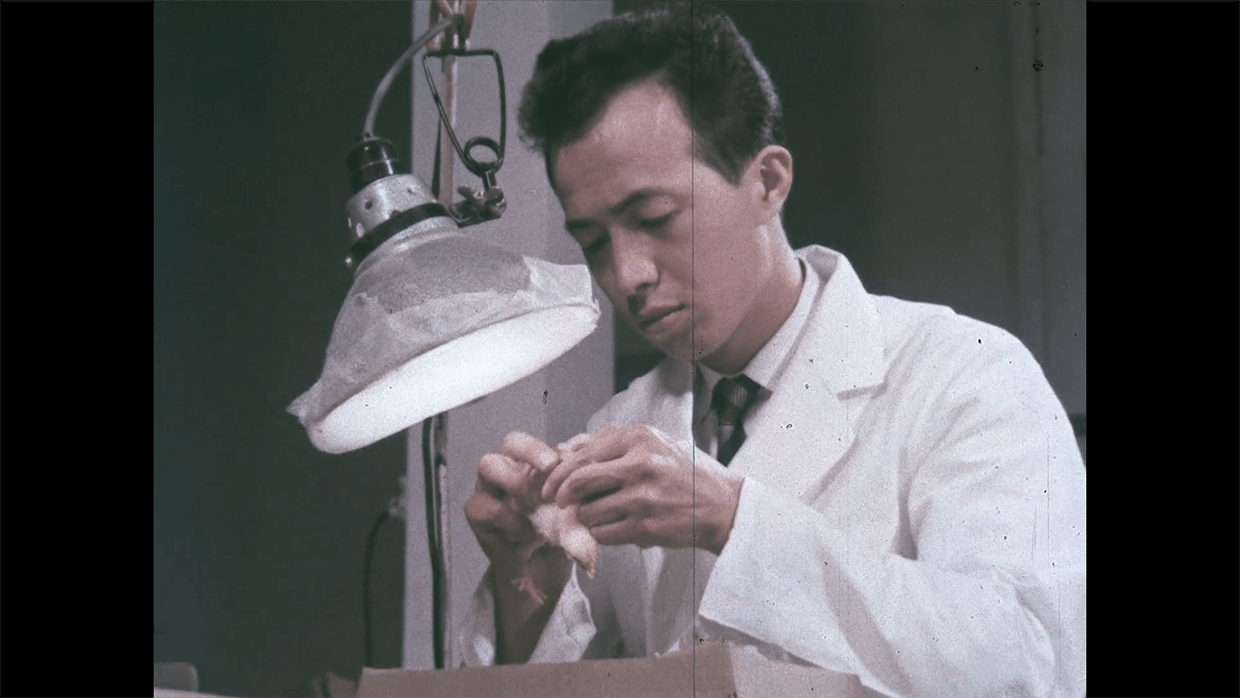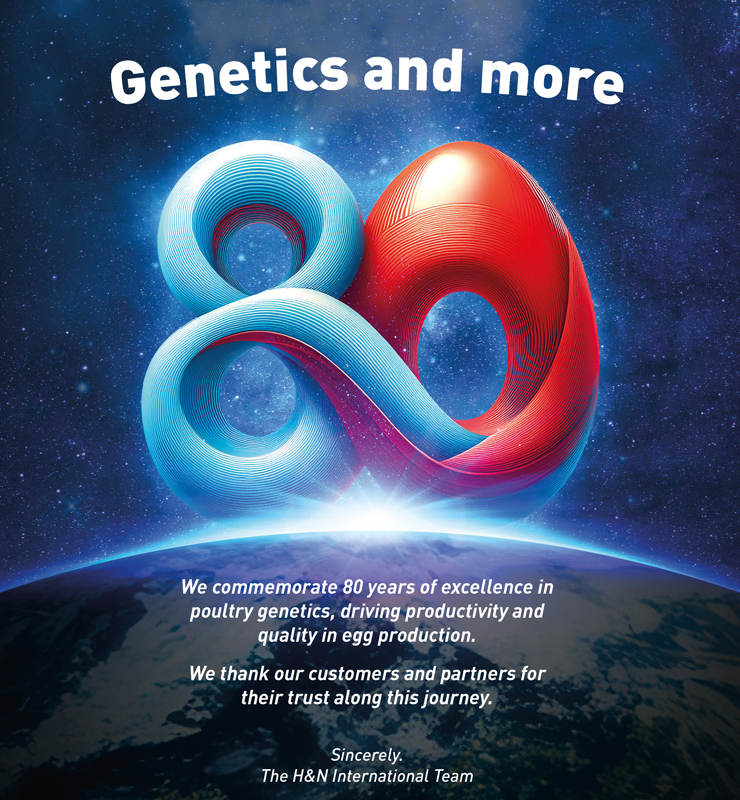When science took over
When science took over
the hen house Original footage with Arthur Heisdorf! Old movie from 1960s shows H&N International’s revolutionary breeding...

When science took over
When science took over
the hen house Original footage with Arthur Heisdorf! Old movie from 1960s shows H&N International’s revolutionary breeding...
When science took over
the hen house Original footage with Arthur Heisdorf!
Old movie from 1960s shows H&N International’s revolutionary breeding method
Luckily, Art and Mary Heisdorf left more than one original source besides their big brown personal scrapbook with newspaper clippings, original letters and early marketing materials.
And another such treasure was found in our archive in 2022, sitting in an old, rust-encrusted round film container! It had been out of plain sight, buried under a heavy pile of boxes with other outdated materials, and had rested there undiscovered and forgotten.
For how many years we didn’t know when we found it there. And likewise, it was at first unclear what this round, rusty old can contained, if it contained anything at all.
It’s truly a treasure on film!
“Yuck! It’s probably some old worthless junk. Throw it away, it’s just taking up the much-needed space for our new stuff!” said one of us when looking at the rusty container with a mixture of doubt and repulsion.
“No! Stop! Give me that! Maybe there’s a film inside! Maybe it’s unique! Maybe even priceless!” said another, and wouldn’t let go of the ominous container.
Opening the treasure box
Indeed, inside there was a film reel. A film of what was apparently celluloid, coiled up on a film spool, some 20 centimeters in diameter! This was oooooold stuff! And not just a short movie, but a longer one, at least 20 minutes we guesstimated with growing excitement.
We didn’t know at that time if it had anything to do with H&N International at all.
A look at the label on top of the container didn’t give any clues to the movie’s secrets or the year it was shot, either. Carefully looking at the first frames, we had to know more. We wanted to see the entire movie. The decision was made to digitize it.
But that was easier said than done, because old movies need old projection equipment to be shown, and few specialized companies still have such working equipment. Mostly archives and museums have it, but they also draw in boatloads of their own material and often lack the resources, staff, time and budget to help with external requests.
Thanks to our video expert agency La Marmota Insomne, the movie was not only digitized but also subtitled in English. And when they called us up, they enthused: “It’s truly a treasure on film!”
Starring Nick Chick, Art Heisdorf and many more
We still could not determine the year it was made, since it isn’t stated anywhere. Judging from the contents and the people portrayed, the film was probably made around 1960, maybe even before.
It tells the story of how Art Heisdorf introduced the first iconic breed, the Nick Chick, to the German and European Markets.
N International had been looking for licensees overseas and contracted Lohmann in 1959 as the first distributor. Soon, Nick Chick found further customers. Post-war German and European markets readily embraced the new breeding methods and computer-based modern scientific selection coming from the US, and so H&N’s Nick Chick helped many companies grow bigger and bigger, ultimately to world leadership.
Early computing with IBM
The movie also shows former Chief Geneticist Max von Krosigk sitting with H&N founder Art Heisdorf. In the next shot, the computing part of layer breeding is portrayed: Art Heisdorf had used IBM computers for his big data selection already in the US as early as 1951 or 1952. And he brought IBM’s technology to Cuxhaven, too, as early as the 1960s.
An article published in the iconic Businessweek (today called Bloomberg Businessweek), the issue of 16th March, 1963, is called “Science takes over the hen house”. It’s about Art and Mary Heisdorf’s revolutionary breeding approach and the deployment of computing technology to process all the data the couple collected meticulously. “Science takes over the hen house” would also be a great title for the old movie.
At that time, a computer would occupy an entire room and specialized staff would operate computers with paper punch cards. Each chick got its own punch card shortly after hatching.
It was around the same time that Americans deployed IBM computers in their space program, calculating flight path angles and supplies to finally send a team to the moon in 1969—the Hollywood Movie Hidden Figures tells the story of early IBM computing and the specialists operating them.
The creative driving force behind using computing technology in breeding to process huge amounts of data persists today, just way smaller and faster. Not just one technical quantum leap but many since have put far more data and functionality into our hands in much smaller, better and faster computer devices.
Art and Mary Heisdorf surely would have loved KAI, H&N’s farming assistant powered by artificial intelligence, because KAI is the logical follow-up to the early IBM computing giants.

Cover of Business Week, March 16, 1963
On the cover: Jules C. Stein physician, businessman and founder of MCA (Music Corporation America) Inc., originally an artist’s agency, Lew Wassermann, businessman, talent agent and “legendary movie mogul” and Milton Rackmil, Vice-Charman of MCA Inc.
Art and Mary Heisdorf surely would have loved KAI, H&N’s farming assistant powered by artificial intelligence, because KAI is the logical follow-up to the early IBM computing giants
Back to the roots—H&N International’s beginnings
It’s a fun fact to know that today a Microsoft office building stands on a former Heisdorf Hatchery in Redmond, Seattle (WA). You could almost say it “hatched” there in 1979, two decades after Art and Mary Heisdorf had already been using modern computing power, albeit from IBM, in their genetic work.
Three historic societies in the US foster the heritage and memory of Art and Mary Heisdorf: The Redmond Historical Society, Kirkland Heritage and Woodinville Heritage, all located close to Seattle, Washington.
It’s very interesting to see the influence of chicken breeding on the American agricultural sector, the changes in nationwide nutrition, and the modernization and export of breeding success to the entire world.
And still today, H&N International continues to be a leading brand in farming software, too: H&N’s digital farming assistant KAI is currently unparalleled by any other in terms of scope, functions, flawless scalability and overall user-friendliness. It has always been genetics and more!

